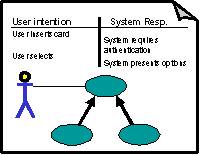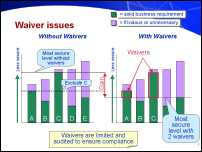Analyzing workflow, roles, and tasks with a quality attribute perspective for high-value innovations
The key concept of a fitness-centered approach to technology and engineering is the usage paradigm. Who buys the technology? What is it supposed to accomplish and who benefits? What workers (or players) interact with the technology, and what is the value proposition? For each of these questions, there are stakeholders—people who are involved in the acquisition, installation, and success of a technology.

Essential use cases are key to determining the correct technology fit
The concepts are not complicated. If you buy a car for you and your family, you will soon find out (if you didn't already know it) that your passengers are stakeholders. If the design fits their usage patterns, they are satisfied. You will soon hear about designs that are not well suited to their needs! Fortunately, the car makers have legions of marketing people worrying about cup holders and other important passenger needs!
Newer and/or less familiar technologies are often built without adequate attention to fitness. Even relatively familiar technologies such as mobile phones and digital cameras vary widely in how well they satisfy key or focal uses and how successfully they trade off one need against another.
Analysis
Each field of technology seems to have its own models, methodologies, and best practices. This body of knowledge may be formal, with certifications like the CISSP security certification. Lists of guidelines can appear to be in direct conflict. Experience and a sense of perspective are often needed to help identify which practices and approaches are the most applicable.
Formalisms tend to suffer from scale. A simple approach that works on a classroom example can become unwieldy when applied to real-life problems. There are often too many variables or parameters. Tools that implement formalisms can be rigid, preventing the free flow of design ideas, such as using both a top-down and bottom-up approach.
We believe that a successful approach to both designing and selecting technology requires careful analysis of roles, workflows, and tasks. Also important is determining who the various stakeholders are and how to provide value to them. At APConnsulting, LLC, we have approaches for determining stakeholder requirements and expectations, and using that information to drive technology selection and design. Stakeholders can identify important roles.
The concept of a role is simple; yet, key roles are often overlooked. In highly technological systems, the operator or end user may be only one of many roles. Other roles may include servicing (diagnosing and fixing problems, or performing upgrades), managing (correcting errors such as incorrect scan at a checkout point of sale terminal), policy (defining different sets of privileges depending on the trust, training, and usage needs of individuals occupying specific roles), and so forth.
In a given role, what is the usage scenario? Typically there are tasks and perhaps a more formal workflow, defining a sequence of tasks with decision points. A task can be described by formalisms such as use cases (originally defined by Ivar Jacobson).
Essential Use Cases
Essential use cases are an abstraction of use cases, meaning that they focus more on the concept than the implementation. For example, when defining authentication to an ATM machine, a use case may describe inserting a card with a magnetic stripe and entering a PIN whereas an essential use case just lists authentication.
Essential use cases are particularly powerful because they help focus on the “what” rather than the “how.” With rapidly changing technology, focusing in what needs to be accomplished can be key to creating adaptive and forward-looking products and solutions.
We at APConnsulting, LLC believe that the fitness-centered perspective helps identify how to apply methodologies to critical areas of the development process. We can show, for example, that security policies and procedures can sometimes be made even more secure with a formal waiver process—even though this may seem counterintuitive.

Security Waiver Process-- some unintuitive results
Some approaches, such as state diagram and activity diagrams lend themselves directly to fitness-centered approaches. Essential use cases can quickly identify key interaction steps without being burdened with the specifics of an implementation. Less formal methodologies are often needed to capture “soft” business-related principles and drivers. Such information may be critical to understanding some of the subtle aspects of the expected usage scenarios.
We are unaware of any formal approach that fully addresses fitness-centered requirements capture and solution development with a suitable consideration of system quality attributes. Techniques and formalisms need to be applied as needed to accomplish the overall goal of a solution that the stakeholders see as valuable and effective because it fits their usage patterns. The goal, after all, is more sales and satisfied customers.
An 80/20 “bang-for-the-buck” approach will avoid seeking completeness or perfection, when “satisficing” (a combination of satisfy and suffice) is really the overall fitness requirement.
Whether you are selecting technology or designing and building it, APConnsulting, LLC can provide services to you. We can help you identify your stakeholders and their needs and expectations. We can then “drill down” to the roles, workflows, and tasks. We can develop and validate the essential use cases, and engineer the designs and trade offs, including key quality attributes for you and your stakeholders’ needs.
| • | • | • | • | • | ||||||
Copyright © 2005-2010, Alex Conn, APConnsulting, LLC. All Rights Reserved. www.apconnsulting.com
|
||||||||||
